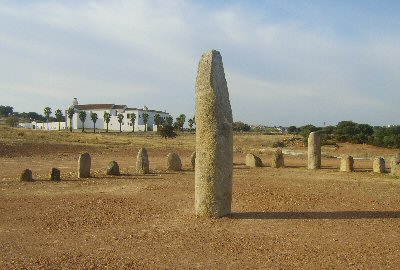The Xerez (Xarez) menhir / Stone-circle (quadrangle):
Originally 5 km south of Monsaraz,
the reconstitution of the
Xarez stone-circle beside the Convento
do Orada
was only possible after some research since the original monoliths had been spread
apart by agricultural works. Today we are greeted with around 50
medium-sized rounded stones in an approximate square formation,
centred with a 4m+ high, 7-ton menhir.
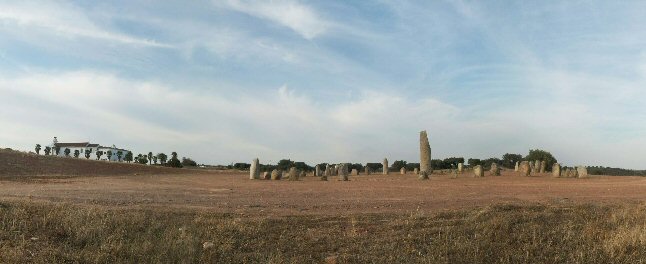
Until 2002, the monument was located 5 Km south
of Monsaraz, around 200 metres west of the road that connected
Monsaraz to the bridge that crossed the Rio Guadiana.
(5)
The site plaque
states that: 'The Whole group had been artificially put
together in the 20th century, resulting from the collection and
arrangement of small monoliths and manual grindstones around the
great menhir, which is 4m high'.
The
research by Dr. Pires Gon�alves
in the 1970's concluded that the monument was probably erected
between 4,000 BC and 3,000 BC and that its original design had
been quadrangular, consisting of 55 menhirs between 1.2 - 1.5
metres high. The stones are described as being both phallic and
rounded as at Almendres. It took Gon�alves until 1972 to complete
the reconstruction.
One of the smaller menhirs was
controversially decorated following reports of a conglomeration of
'dimples' on the flat face of one of the original stones.
(5)

The 'Xarez' monument - before it was
relocated.
Shortly
after the reconstruction, several small granite menhirs were found
300m north, all engraved on their bases
(4).
They were Classified with IIP as (Dec. n� 1/86, DR 2 de 03 Janeiro 1986)(5).
|
Rectangular Enclosures and their Latitudes.
There is a stone-quadrangle at
Carnac, which has the peculiar property of having the same angle
between diagonal corners as its latitude - a property also shared by
the 'Station-stones' at Stonehenge.
It should also be remembered in
relation to this, that Stonehenge and Almendres were both located at
particularly significant lunar Latitudes (Both being positioned
under the latitude of the moons extreme azimuths).
The azimuth of 100�
between Almendres and Xarez cromeleques has also been tentatively
suggested as having been related to the azimuth of the full spring moon
(3). Of interest is the fact that the spectacular
Anta Grande da Zambujeiro also
sits along the same proposed 50km 'alignment', although none of the
sites are inter-visible. The same alignment continues eastwards towards Lisbon.
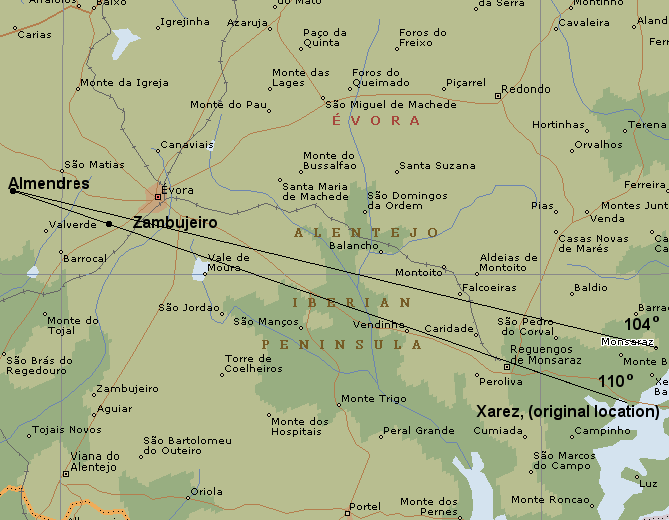
An alignment from Almendres to the original
location of the Xarez monument (through Zambujeiro) produces an
approximate azimuth of 110�, while an alignment to Monsaraz is much
closer to the expected 100� (+/- 104�).
Da Silva and Calado
proposed that: 'A very simple observation could have been
realized in megalithic times, in which the azimuths of the rising
Sun and of the rising Full Moon, after Midwinter, are getting closer
until they cross-over, i.e. until the Full Moon is seen to rise
South of the direction in which the Sun was observed to rise in the
same day. We know that this occurs about the time of the Equinox,
and this cross-over may be used to provide an alternative definition
of the "megalithic equinox". (5)
It should be noted that the Xarez rectangle
consists of 55 stones (55.8 = 3 x 18.6), three full lunar cycles.
(More about Stone 'Quadrangles) |
The Monsaraz Menhirs:
There are several
other menhirs in the region of Monsaraz,
with further suggestions of astronomy through the engravings and the alignments
formed between them.
Menhir Bulh�o/Belhoa:
This menhir was identified in 1970, when it was found fallen and 'broken'
according to the site plaque. According to Evans & Mohammadi
(2),
when the menhir was first found, it is said that the local farmers
'chopped' off a third of it to make an olive press'. Whatever,
the truth, today, the original top section rests
on a modern granite reconstruction. (If it was found 'broken',
one wonders where the other original part/s are today?).
The menhir is
suggested to have been erected as early as the 5th or 6th millennia
BC (Ref: Site plaque), which would make it the earliest
monument in the region.
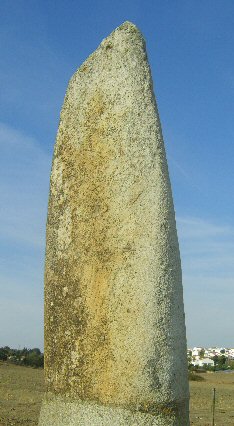

There are several
prominent engravings still just visible on the upper-half of the menhir
including a 'sun' shaped symbol, several 'crook's', and 'serpentine-wavy'
lines), familiar only in style to the engravings inside
Gavr'inis passage-mound in France, similarly
dated at around 4,500 BC).

The peak of
Monsaraz lies exactly 180� to the South, although the natural
orientation of the stone follows the proposed 100� azimuth of the
spring moon.
The general
tapering end and 'fin-like' profile reasonably preclude it from
having had any association to phallus.

Menhir of Outeiro ('Penedo
comprido', 'The long rock'):
About 3km (2 miles) north of Monsaraz,
is the tallest (5.6m/18ft), menhir in the region, and second only in
size to the Menir Meada, near
Castelo de Vide in all Iberia.
The stone weighs around 8 tons and was
beautifully shaped and erected to lead an apparently solitary life
in the flatlands, with Monsaraz alone looming in the background.
There is a slight depression along the top which has led to the
common assumption that it was originally phallic by design.
There is a noticeable difference
between the patina on the exposed face of the rock compared to the
pale-sandy colour of the buried face, due to the fact that it
remained prostrate for so long.
Roche das Namorados: ('The
Lovers Rock', 'Fiance's Rock', 'Uterus rock')
The 'Roche das Namorados' is actually a natural granite outcrop. It is occasionally
referred to as 'mushroom-shaped' or 'Uterus' shaped, but its shape
varies depending on where one stands. The stone has several large
'dimples' or 'cup-marks' on it, a common feature on Neolithic
remains, although there is no way of proving their origin or
meaning.


Local tradition has
given the stone a certain 'pathos'. It is said that if a
woman stands with her back to it and throws stones onto it, the
number of attempts represents how many years it will be until she
gets married.
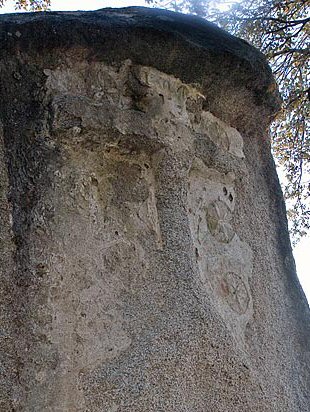
The stone has been
'Christianised' signifying
its importance.
Other Megaliths in the
Monsaraz region:
Dolmen - Cebolinhas (Reguengos
de Monsaraz)
Dolmen - Poso (Reguengos de Monsaraz)
Dolmen - Oliva da Pega (Reguengos de Monsaraz)
Menhir - Barrocal (Reguengos de Monsaraz)
Menhir - Gaginos (Reguengos de Monsaraz)
Menhir - Herdade da Capela (Reguengos de Monsaraz)
Menhir - Monte do Limpo (Monsaraz)
Menhir - Penedo Gordo (Reguengos de Monsaraz)
Menhir - Povoado de Perdig�es (Reguengos de Monsaraz)
